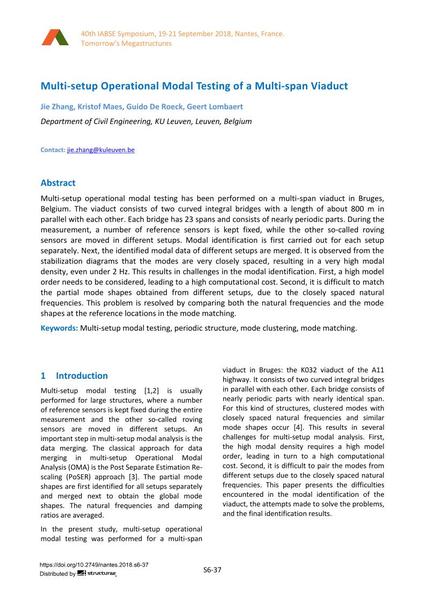Multi-setup Operational Modal Testing of a Multi-span Viaduct

|
|
|||||||||||
Détails bibliographiques
| Auteur(s): |
Jie Zhang
(Department of Civil Engineering, KU Leuven, Leuven, Belgium)
Kristof Maes (Department of Civil Engineering, KU Leuven, Leuven, Belgium) Guido De Roeck (Department of Civil Engineering, KU Leuven, Leuven, Belgium) Geert Lombaert |
||||
|---|---|---|---|---|---|
| Médium: | papier de conférence | ||||
| Langue(s): | anglais | ||||
| Conférence: | IABSE Symposium: Tomorrow’s Megastructures, Nantes, France, 19-21 September 2018 | ||||
| Publié dans: | IABSE Symposium Nantes 2018 | ||||
|
|||||
| Page(s): | S6-37 | ||||
| Nombre total de pages (du PDF): | 8 | ||||
| DOI: | 10.2749/nantes.2018.s6-37 | ||||
| Abstrait: |
Multi-setup operational modal testing has been performed on a multi-span viaduct in Bruges, Belgium. The viaduct consists of two curved integral bridges with a length of about 800 m in parallel with each other. Each bridge has 23 spans and consists of nearly periodic parts. During the measurement, a number of reference sensors is kept fixed, while the other so-called roving sensors are moved in different setups. Modal identification is first carried out for each setup separately. Next, the identified modal data of different setups are merged. It is observed from the stabilization diagrams that the modes are very closely spaced, resulting in a very high modal density, even under 2 Hz. This results in challenges in the modal identification. First, a high model order needs to be considered, leading to a high computational cost. Second, it is difficult to match the partial mode shapes obtained from different setups, due to the closely spaced natural frequencies. This problem is resolved by comparing both the natural frequencies and the mode shapes at the reference locations in the mode matching. |
||||
